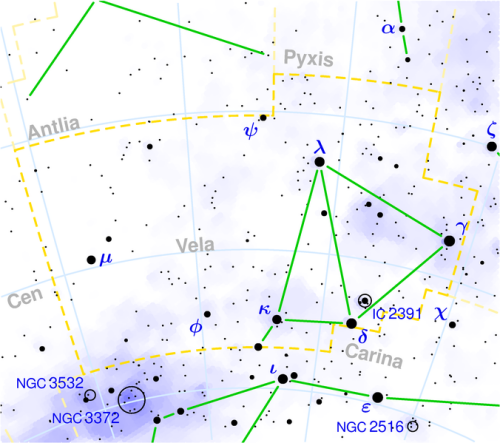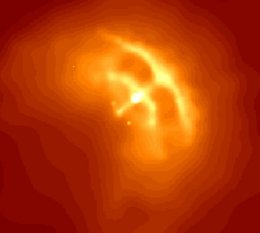Vela

Vela. © 2003 Torsten Bronger.
Vela (abbreviation: Vel), the Sails, is a constellation of the southern hemisphere that together with Carina, Puppis, and Pyxis, formed Argo Navis. Vela lies west of Centaurus and north and east of Carina, and occupies a region of sky extremely rich in star fields. See below for details of the constellation's brightest stars and interesting deep sky objects.
Vela Pulsar
 |
| X-ray emission nebula surrounding the Vela Pulsar
imaged by the Chandra X-ray Observatory.
|
The Vela Pulsar (PSR 0833-45) is a pulsar associated with the Vela Supernova Remnant and lying at a distance of about 815 light-years. It is one of the youngest pulsars known and one of the few that has been detected at visible wavelengths. The lengthening of its short period of 89 milliseconds by 10.7 nanoseconds per day gives a maximum age of some 11,000 years. In 1977, nine years of its discovery, it was seen to be flashing at visible wavelengths and thus became the second optical pulsar on record, after the Crab Pulsar. It is also one of the strongest radio pulsars, the strongest gamma-ray source in the sky, and a powerful X-ray source associated with Vela X-2.
Vela X-1
Vela X-1 is an eclipsing X-ray binary pulsar with an orbital period of 8.96 days. It is a particularly intense emitter of hard X-rays.
Brightest stars and other objects of interest in Vela
| Stars in Vela brighter than magnitude 4.0 | ||||||
|---|---|---|---|---|---|---|
| star | vis mag | abs mag | spec type | distance (ly) | RA (h m s) | Dec (° ' ") |
| Gamma (Regor) | 1.75 | -5.31 | WC8+O7.5e | 841 | 08 09 32 | -47 20 12 |
| Delta (Koo She) | 1.93 | -0.01 | A1V | 80 | 08 44 42 | -54 42 30 |
| Lambda (Al Suhail al Wazn) | 2.23v | -4.00 | K4Ib | 573 | 09 08 00 | -43 25 57 |
| Kappa (Markab) | 2.49 | -0.67 | B9III | 140 | 09 22 07 | -55 00 38 |
| Mu | 2.69 | -0.06 | G5III+G2V | 116 | 10 46 46 | -49 25 12 |
| Phi (Tseen Ke) | 3.52 | -5.34 | B5Ib | 1,930 | 09 56 52 | -54 34 03 |
| Psi | 3.60 | 2.25 | F3IV+F0IV | 61 | 09 30 42 | -40 28 00 |
| Omicron | 3.60 | -2.31 | B3IV | 495 | 08 40 18 | -52 55 19 |
| c | 3.75 | -1.13 | K2III | 309 | 09 04 09 | -47 05 02 |
| p | 3.84 | 1.72 | A3V | 86 | 10 37 18 | -48 13 32 |
| q | 3.85 | 1.35 | A2V | 103 | 10 14 44 | -42 07 19 |
| a | 3.87 | -4.52 | A1III | 1,550 | 08 46 02 | -46 02 30 |
| Other objects of interest | ||
|---|---|---|
| name | type of object | notes |
| IC 2391 | open cluster | A bright, close group around Omicron Vel, visible to the naked eye but best seen with binoculars. Magnitude 2.5; diameter 50'; RA. 09h 40.2m, Dec. -53° 04'. |
| IC 2395 | open cluster | Magnitude 4.6; diameter 8'; RA 08h 41.1m, Dec -48° 12'. |
| NGC 2547 | open cluster | About 50 stars of seventh magnitude and fainter, visible with binoculars. Magnitude 4.7; diameter 20'; RA 08h 10.7m, Dec -49° 16'. |
| NGC 3201 | globular cluster | Magnitude 4.7; diameter 18'; RA 10h 17.6m, Dec -46° 25'. |
| Eight-burst Nebula | planetary nebula | NGC 3132. See separate entry. |
| Constellations |
| Andromeda | Antlia | Apus | Aquarius | Aquila | Ara | Aries | Auriga | Bootes | Caelum | Camelopardalis | Cancer | Canes Venatici | Canis Major | Canis Minor | Capricornus | Carina | Cassiopeia | Centaurus | Cepheus | Cetus | Chamaeleon | Circinus | Columba | Coma Berenices | Corona Austrina | Corona Borealis | Corvus | Crater | Crux | Cygnus | Delphinus | Dorado | Draco | Equuleus | Eridanus | Fornax | Gemini | Grus | Hercules | Horologium | Hydra | Hydrus | Indus | Lacerta | Leo | Leo Minor | Lepus | Libra | Lupus | Lynx | Lyra | Mensa | Microscopium | Monoceros | Musca | Norma | Octans | Ophiuchus | Orion | Pavo | Pegasus | Perseus | Phoenix | Pictor | Pisces | Piscis Austrinus | Puppis | Pyxis | Reticulum | Sagitta | Sagittarius | Scorpius | Sculptor | Scutum | Serpens | Sextans | Taurus | Telescopium | Triangulum | Triangulum Australe | Tucana | Ursa Major | Ursa Minor | Vela | Virgo | Volans | Vulpecula |


